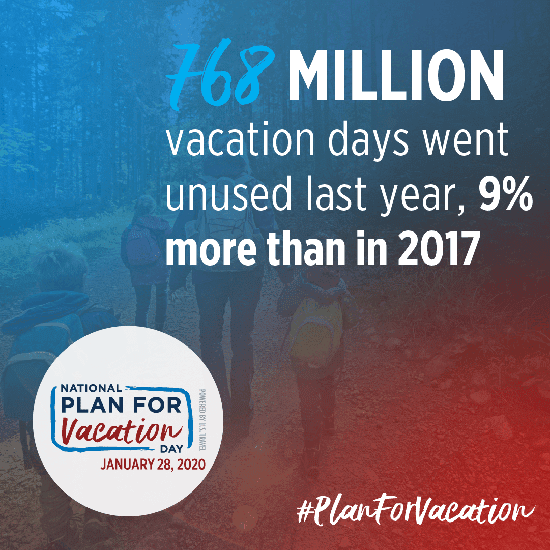Planning increases vacation time use and elevates physical and mental health
BOISE – (January 29, 2020) – American workers are earning and using more vacation time, but they’re still leaving a lot of it on the table – to the tune of 768 million unused days last year. That represents nearly $65.5 billion in lost benefits, the equivalent of each worker donating $571 in free labor to his or her company.

January 28 was National Plan for Vacation Day, and AAA reminds Idaho families to make travel plans early in the year to prevent outside pressures from limiting their opportunities for a well-deserved vacation. According to a 2019 study by Project: Time Off, Idaho ranks 41st in the country for using available vacation time.
“Idahoans have a strong work ethic, but missing out on vacation time can impact health and wellness,” says AAA Idaho spokesman Matthew Conde. “In general, planners report that they are happier in their personal relationships, with their use of time off, and with their organization than non-planners. They also reported higher levels of physical health and well-being.”
The average employee tends to earn 20.3 days of vacation time, but only uses 17.4 days each year.
“Planning your vacations early in the year keeps others from filling your calendar for you – and there are few things that are worse than not feeling in control of your own life,” Conde said. “Early planning also gives you more time to work out a travel budget and save accordingly.”
Vacation planning by the numbers
- Planners are more likely than non-planners to travel on their vacation days (76% vs. 50%)
- More than half of planners have completed a vacation in the past six months, compared to just 36% of non-planners
- The majority of Americans (83%) say it is important to travel with their time off, but they only use half of their vacation days to do so
- Only 54% of American households make time to plan out their vacation days each year
- If Americans used a few more days off to travel, it could generate an additional $151.5 billion in travel spending, with the potential to add two million jobs to the U.S. economy
Americans ages 18 to 34 are less likely to plan out their vacation time than older counterparts. While seniors took more time off than younger groups, Millennials used a greater portion of their time off to travel. Some of Americans’ favorite reasons to travel include reducing stress, having fun, and making memories.
AAA travel advice
Get started, even without the full plan. Block out dates that will work for your family, and then protect them against outside commitments.
Do your homework. Start by picking a destination, or at the very least, a direction. Then determine how far you want to travel each day, and build in appropriate stops along the way.
Get off the beaten path. Popular travel destinations can quickly become crowded, leading to more stress. Mix in some stops at lesser-known places to get a break from the chaos.
Don’t worry about doing it all. If you really enjoy a destination, tell yourself that you’ll have plenty of reasons to go back. Group the available activities into A (must see), B (somewhat important) and C (nice if we get to it) categories. Start by building in the ‘A’ activities, then fill in with ‘B’ and ‘C’ around them.
Take a different route home. If it makes sense and fits your time constraints, taking a loop to return home might hold everyone’s attention better than traveling home in reverse.
Talk to a travel professional. Rely on expert advice to learn more about ways to save and activities to do that you wouldn’t have discovered on your own.

